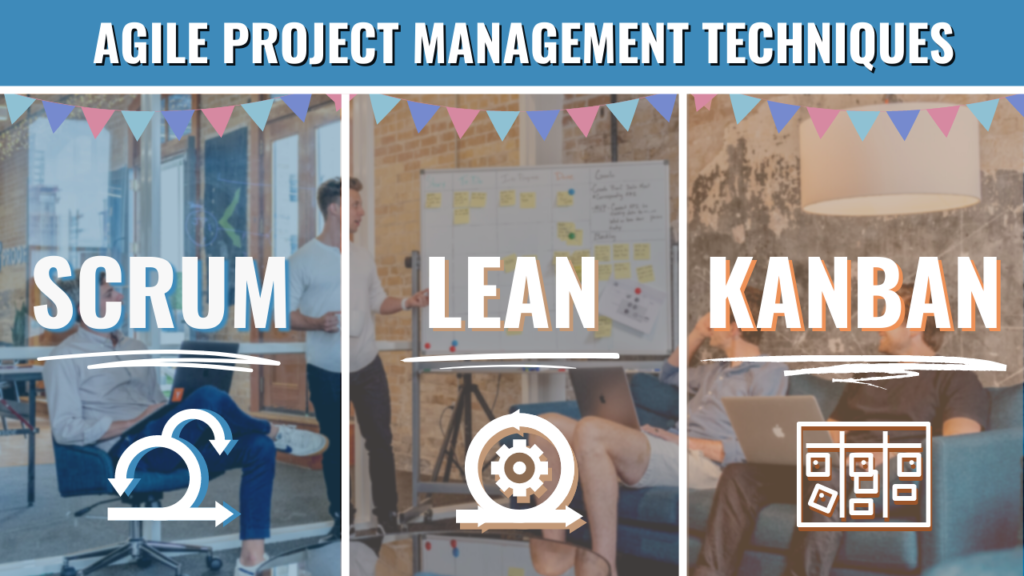Scrum, Lean, or Kanban? Find out which agile system should you consider. Know the practices and values of Scrum, Lean, and Kanban.

Introduction
As organisations are becoming more and more conscious about increasing efficiency, removing waste, and building cross-functional teams for faster outputs, Agile management systems are becoming increasingly popular in the modern world. These methods help organizations become more responsive, flexible, and adaptive to change. Among the most popular agile systems are Scrum, Lean, and Kanban.

Each Agile management system has positives and negatives and can be used in different situations. The above-given picture shows statistics on which Agile method. Scrum is largely used for complex projects, Lean improves flow and increases value, and Kanban is used for managing and visualizing workflow.
These skills are offered as short courses for people who want to specialize their project productions using any of these systems. We will explore the similarities and differences between these Scrum, Kanban, and Lean, and know how these three systems can be used to improve the efficiency and effectiveness of your organization.
Scrum
Scrum is an iterative and incremental framework often used in software development. It is based on small, cross-functional teams working together to deliver valuable products or services. Scrum uses a set of defined roles, ceremonies, and artefacts to guide the team’s work.

The 5 key principles of Scrum include:
- Self-organization
- Collaboration
- Value-based prioritization
- Time-boxing
- Iterative development
Lean
Lean is a philosophy that traces its origin to the principles of the Toyota Production System. Mainly, it focuses on waste reduction, flow improvement, and increasing customer value. It is often used in manufacturing and service industries.

The 5 key principles of Lean include:
- Point out the value
- Identify value stream
- Creating the flow
- Pull system
- Perfection
Kanban
Kanban is a visual system for managing work and uses a Kanban board to visualize the workflow and firmly emphasizes limiting work in progress to improve flow and reduce lead times. Software development and IT companies often prefer Kanban .

The 4 key principles of Kanban include:
- Visualize the flow
- Limit work in progress (WIP)
- Focus and flow
- Continuous improvement
The below-given table highlights the key differences between practices and values of Scrum, Lean, and Kanban agile systems:
| Scrum | Lean | Kanban | |
| Practices |
Short meetings where team members discuss what they accomplished the previous day and what they plan to work on today.
A meeting where the team sets goals and plans for the upcoming sprint.
A meeting is held for the team to look at their previous sprint and point out areas that need improvement.
A hierarchical list of features and tasks must be completed for the item.
A team member who acts as a facilitator and helps the team follow Scrum practices. |
A continuous improvement process that encourages team members to identify and eliminate waste.
A tool used to identify and improve workflow from start to finish.
A visual tool used to track the flow of work and identify bottlenecks.
A system where work is pulled into the process as needed rather than being pushed through the process.
A system for organizing and maintaining a clean and efficient work environment. |
Use a Kanban board to visualize the flow of work and identify bottlenecks.
you can reduce the number of tasks at one go.
Use pull systems to manage the flow of work and minimize delays.
Clearly define the process and policies that govern the workflow.
Regularly gather feedback to improve the process continuously. |
| Values |
Scrum promotes open communication and visibility of progress to all stakeholders.
Scrum encourages the team to inspect their work regularly and adjust as needed.
Scrum allows changes throughout the project based on new information and feedback.
Scrum requires team members to speak up and take responsibility for their actions.
Scrum prioritizes the most critical tasks to be completed and worked on. |
Lean encourages teams to look for ways to improve processes and reduce waste continuously.
Lean values the contributions and opinions of all team members.
Lean focuses on identifying and removing unnecessary steps in a process.
Lean emphasizes the importance of creating a high-quality product or service.
Lean encourages teams to learn and share knowledge to improve processes. |
Kanban uses a visual board to show the progress of work and identify bottlenecks.
Kanban focuses on managing workflow to ensure a steady and consistent value delivery.
Kanban encourages teams to clearly define their processes and make them visible to all team members.
Kanban encourages teams to gather feedback regularly and make improvements accordingly.
Kanban encourages team members to work together and improve processes as a team. |
Scrum vs Kanban vs Lean: What are the Similarities?
- All three methodologies prioritize flexibility and adaptability, allowing teams to respond quickly to changing requirements or unexpected obstacles.
- They all focus on continuous improvement and strive for efficiency in the delivery of value to customers.
- Visualization techniques, such as boards or cards, help teams understand workflow and identify bottlenecks.
- Use time-boxed iterations, called sprints in Scrum and iterations in Lean, to deliver incremental improvements.
- All of them take part in promoting active communication and collaboration among the leaders, stakeholders, and the team
Final thoughts
These systems are aimed at being adaptable and flexible, allowing the team to respond quickly to changes in the business environment. By using Scrum, Lean, and Kanban, organizations can better manage their projects, improve workflow, and increase overall efficiency and productivity.
10 FAQs About Scrum, Lean, and Kanban Systems
What is the biggest difference between Scrum, Lean, and Kanban?
Scrum creates iterative sprints to complete projects, Lean focuses on eliminating waste and improving flow, and Kanban utilizes visual tools to regulate workflow and prevent work in progress.
If you had to choose one Scrum, Lean or Kanban?
Choose Scrum for complex projects, requiring cross-functional teams; choose Lean for optimizing the flow, and eliminating waste; and Kanban for workflow visualization in a continuous process.
What are the basic principles of the Scrum methodology?
Scrum principles include self-organization, collaboration, value-based prioritization, time-boxing, and iterative development to achieve project goals.
How will Lean improve efficiency in project management?
Lean aims at identifying value, mapping value streams, creating flow, enabling pull systems, and striving for perfection that reduces waste as well as improves the value for customers.
What is a Kanban board, and how does it help teams?
A Kanban board is a visual tool that is used to track tasks, track bottlenecks, and limit work in progress in place to improve workflow transparency and efficiency of work.
Can Scrum and Kanban be combined in project management?
Yes, ScrumBan combines the structure of Scrum with the flexibility and visualization of Kanban when it is employed to manage changing workflows.
Which industries benefit most from Lean methodology?
Lean is most often applied to manufacturing, health care, and services-based industries due to its focus on value-oriented processes and waste elimination.
What are the benefits of using Scrum in project management?
Some of the benefits of Scrum in project management are: Team collaboration is enhanced, changes are made quickly, incremental value is delivered, and transparency with stakeholder involvement is ensured.
How does Kanban facilitate continuous improvement?
Kanban allows for constant improvement via regular feedback loops, process policies described explicitly, and team collaboration to update workflow, and minimize delays.
Does one need Agile certification in order to be an expert in Scrum, Lean, or Kanban?
While not mandatory, Agile certifications provide structured learning and validation of skills, helping professionals apply Scrum, Lean, or Kanban effectively in real-world projects.

Hardik follows the interface between content, growth, and operations as part of his role at ValueX2. His career as a copywriter made him believe that, “while great content is well-written, it also needs to be well-positioned in the digital landscape”. Therefore, he sometimes views his role as connecting the dots between strategy, audience psychology, data-backed execution, and planning.
Hardik has created content for brands in the EdTech, corporate tax consultancy, and eCommerce sectors. He is currently exploring Agile and Scrum methodologies to infuse greater agility and structure into content development and delivery processes.






